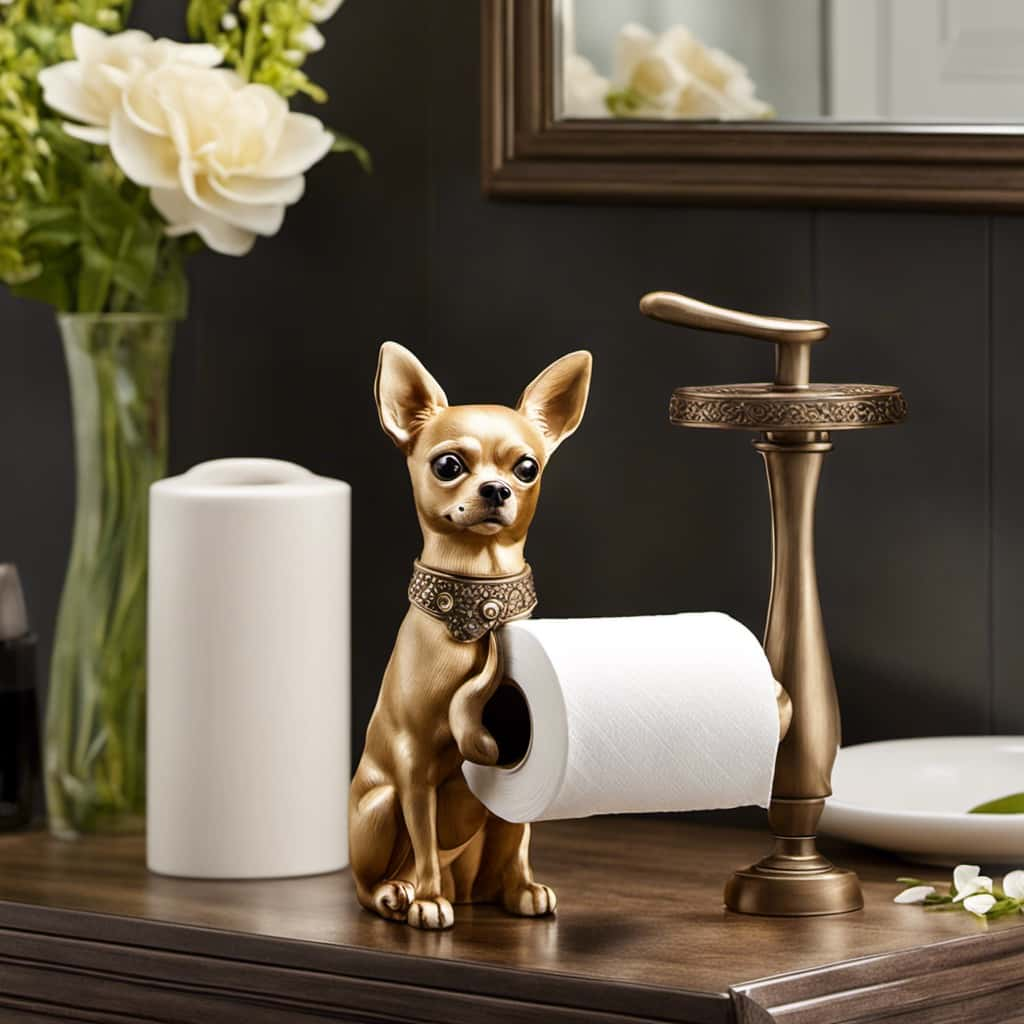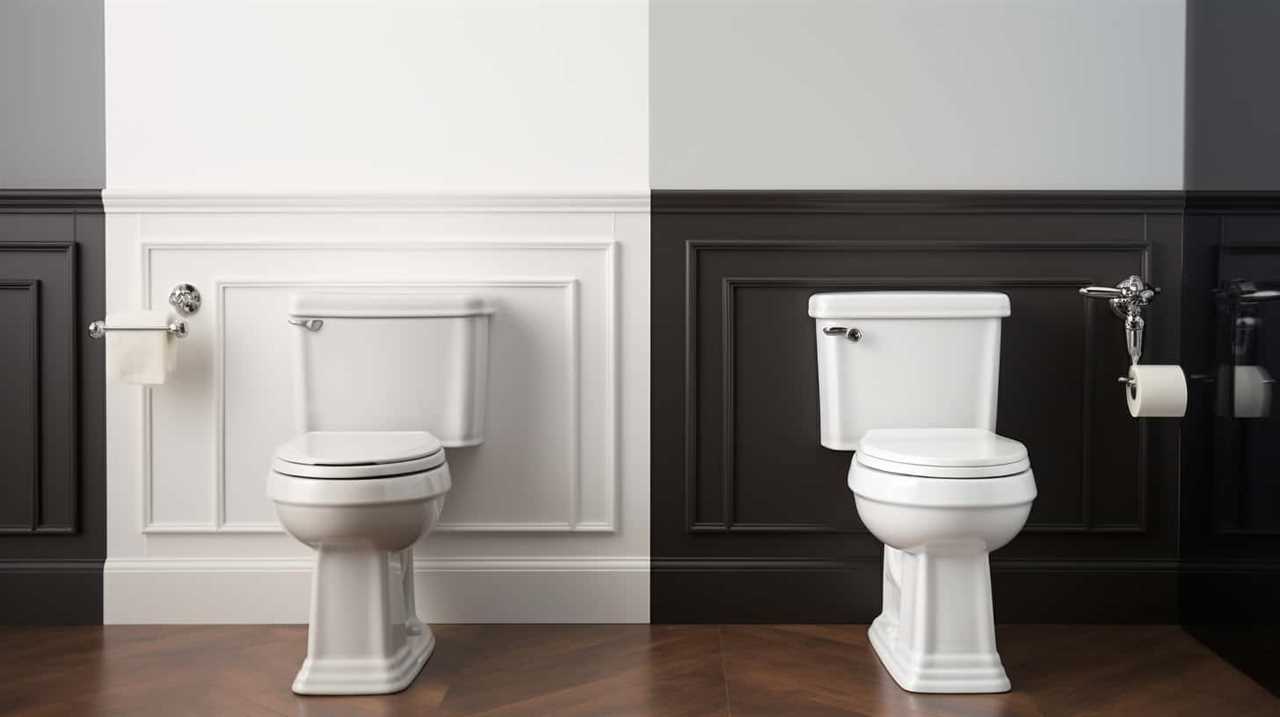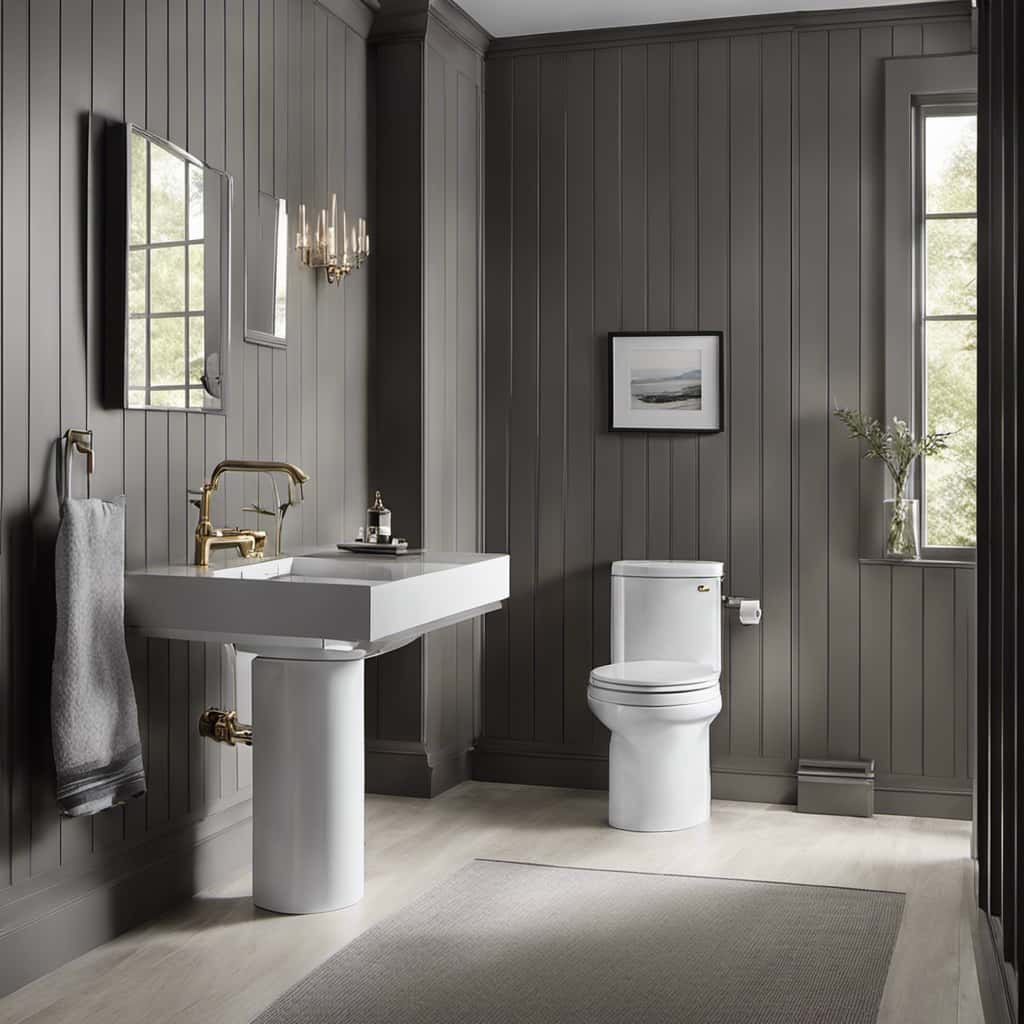- Plumbing system design: How can the layout and design of a plumbing system contribute to pressure imbalances between toilets and showers?
- Water pressure fluctuations: What other factors, such as changes in water supply or demand, can lead to pressure imbalances between toilets and showers?
Ever wondered why your shower mysteriously turns on when you flush the toilet? We get it – it’s quite a head-scratcher. But fear not, for in this article, we will delve into the intricacies of your plumbing system and shed light on this peculiar phenomenon.
From pressure imbalances to malfunctioning shower valves, we’ll cover it all.
So, grab your wrench and get ready to master the mysteries of your shower and toilet interconnection.
Key Takeaways
- Plumbing fixtures and appliances are interconnected within a building, and the proper direction of water flow is crucial to prevent backflow and inadequate water pressure.
- Inadequate pipe sizing, faulty pressure regulating valves, and deposits or debris in the pipes can cause pressure imbalances between the toilet and shower when the toilet is flushed.
- Malfunctioning shower valves, such as leaks, worn-out seals, or faulty cartridges, can also result in water flowing into the shower when the toilet is flushed.
- The water hammer effect, which refers to the sudden increase in pressure when water flow is abruptly stopped, can cause the shower to turn on unexpectedly when the toilet is flushed. Understanding and addressing this effect is important in resolving the issue.
Plumbing System Interconnection
When we talk about plumbing system interconnection, we’re referring to the way different plumbing fixtures and appliances are connected to each other within a building. This interconnection ensures the smooth flow of water throughout the plumbing system.

One important aspect of plumbing system interconnection is the direction of water flow. Proper direction ensures that water flows from one fixture to another in the intended manner, preventing any issues such as backflow or inadequate water pressure.
Another key factor in plumbing system interconnection is the impact of pipe size. The size of the pipes used for interconnection plays a crucial role in maintaining optimal water flow. If the pipes are too small, it can lead to restricted water flow and reduced pressure, resulting in issues such as slow drainage or weak water flow from faucets and showerheads. On the other hand, using pipes that are too large can cause excessive water pressure and inefficiency in the system.
To ensure optimal plumbing system interconnection, it’s essential to consider both the direction of water flow and the appropriate pipe sizes for each fixture and appliance. This will help maintain efficient water flow and prevent any problems that may arise from inadequate interconnection.
Pressure Imbalance Between Toilet and Shower
We experience a pressure imbalance between the toilet and shower. This can be attributed to several factors related to plumbing maintenance and water flow regulation. Here are the key reasons for this pressure imbalance:

- Inadequate pipe sizing: If the pipes connecting the toilet and shower aren’t adequately sized, it can result in a pressure drop when the toilet is flushed, causing the shower to turn on.
- Faulty pressure regulating valve: A malfunctioning pressure regulating valve can fail to maintain a consistent water pressure throughout the plumbing system, leading to pressure imbalances between different fixtures.
- Partial blockage in the pipes: Deposits or debris in the pipes can restrict the water flow, causing pressure imbalances when certain fixtures are used.
- Inefficient water pressure balancing system: If the plumbing system lacks a proper pressure balancing system, the sudden increase in water flow from the toilet flush can disrupt the pressure equilibrium, triggering the shower to turn on.
To resolve this issue, it’s recommended to consult a professional plumber to assess and address the underlying plumbing maintenance or water flow regulation problems.
Malfunctioning Shower Valve
To continue our discussion on the pressure imbalance between the toilet and shower, one possible cause for the shower turning on when you flush the toilet is a malfunctioning shower valve.
The shower valve is responsible for controlling the flow of water to the showerhead. When it malfunctions, it may cause water to flow into the shower when the toilet is flushed, creating the unwanted scenario.
Common shower valve problems include leaks, worn-out seals, and faulty cartridges.

To repair a malfunctioning shower valve, it’s necessary to identify the specific issue and replace the faulty components. This may involve disassembling the valve, inspecting the seals, and replacing any damaged parts.
It’s recommended to consult a professional plumber for proper diagnosis and repair of shower valve problems.
Faulty Pressure Regulator
Another potential cause for the shower turning on when the toilet is flushed is a faulty pressure regulator. The pressure regulator is responsible for maintaining a consistent water pressure throughout your plumbing system. When it malfunctions, it can cause imbalances in water pressure, leading to unexpected changes in flow.
Here are some troubleshooting steps and solutions for dealing with a faulty pressure regulator:

- Check the pressure regulator for any visible signs of damage or leaks.
- Test the water pressure using a pressure gauge to determine if it falls within the recommended range.
- If the pressure regulator is faulty, consider replacing it with a new one to restore proper water pressure.
- Consult a professional plumber for assistance with pressure regulator replacement and troubleshooting water pressure issues.
Understanding the role of a faulty pressure regulator is crucial in addressing the problem of the shower turning on when the toilet is flushed. However, another issue that can contribute to this phenomenon is the water hammer effect.
Water Hammer Effect
When the toilet is flushed, the shower may turn on due to the water hammer effect. Water hammer refers to the sudden increase in pressure that occurs when the flow of water is abruptly stopped or redirected. This can happen when the toilet valve closes quickly, causing the water to slam into the pipes and create a shockwave. The shockwave travels through the plumbing system, causing vibrations and potentially activating other fixtures, such as the shower.
The water hammer effect not only leads to an inconvenience, but it also has implications for water conservation efforts. The sudden surges in pressure can damage pipes and fittings, leading to leaks and wasted water. To prevent this, it’s essential to install devices such as water hammer arrestors or pressure regulators. These devices absorb the shockwaves and maintain a steady flow of water, reducing water waste and preserving the integrity of the plumbing system.
Frequently Asked Questions
Can a Faulty Shower Valve Cause Water to Turn on When Flushing the Toilet?
A faulty shower valve can cause water to turn on when flushing the toilet. This happens due to changes in water pressure. It is important to address the issue promptly to prevent further damage.

What Are the Possible Causes of a Pressure Imbalance Between the Toilet and the Shower?
Possible causes of a pressure imbalance between the toilet and the shower include plumbing system design and water pressure fluctuations. The layout and design of the plumbing system can contribute to pressure imbalances, as well as changes in water supply or demand.
How Does a Malfunctioning Pressure Regulator Affect the Water Flow in the Shower When Flushing the Toilet?
When a pressure regulator malfunctions, it can disrupt the water flow in the shower. This occurs due to an imbalance in pressure caused by the faulty regulator, leading to unexpected activation of the shower when the toilet is flushed.
Is the Water Hammer Effect Only Experienced When Flushing the Toilet, or Can It Occur in Other Situations as Well?
The water hammer effect can occur in other situations besides flushing the toilet. It can happen when valves close abruptly, such as when a dishwasher or washing machine finishes its cycle. To prevent water hammer, install air chambers or water hammer arrestors in the plumbing system.
Are There Any Other Potential Reasons for the Shower Turning on When the Toilet Is Flushed, Aside From the Ones Mentioned in the Article Sections?
Other potential causes for the shower turning on when the toilet is flushed, besides those mentioned, could include faulty plumbing valves or a shared water supply system. The water hammer effect may also impact other situations involving rapid changes in water flow.

Conclusion
In conclusion, the interconnection of the plumbing system is responsible for the shower turning on when the toilet is flushed. This is due to the pressure imbalance between the two fixtures, potentially caused by a malfunctioning shower valve or a faulty pressure regulator.
Additionally, the water hammer effect can also contribute to this issue. So, next time you experience this bizarre phenomenon, remember that your bathroom is performing a symphony of water flow like no other – a true marvel of modern plumbing!










